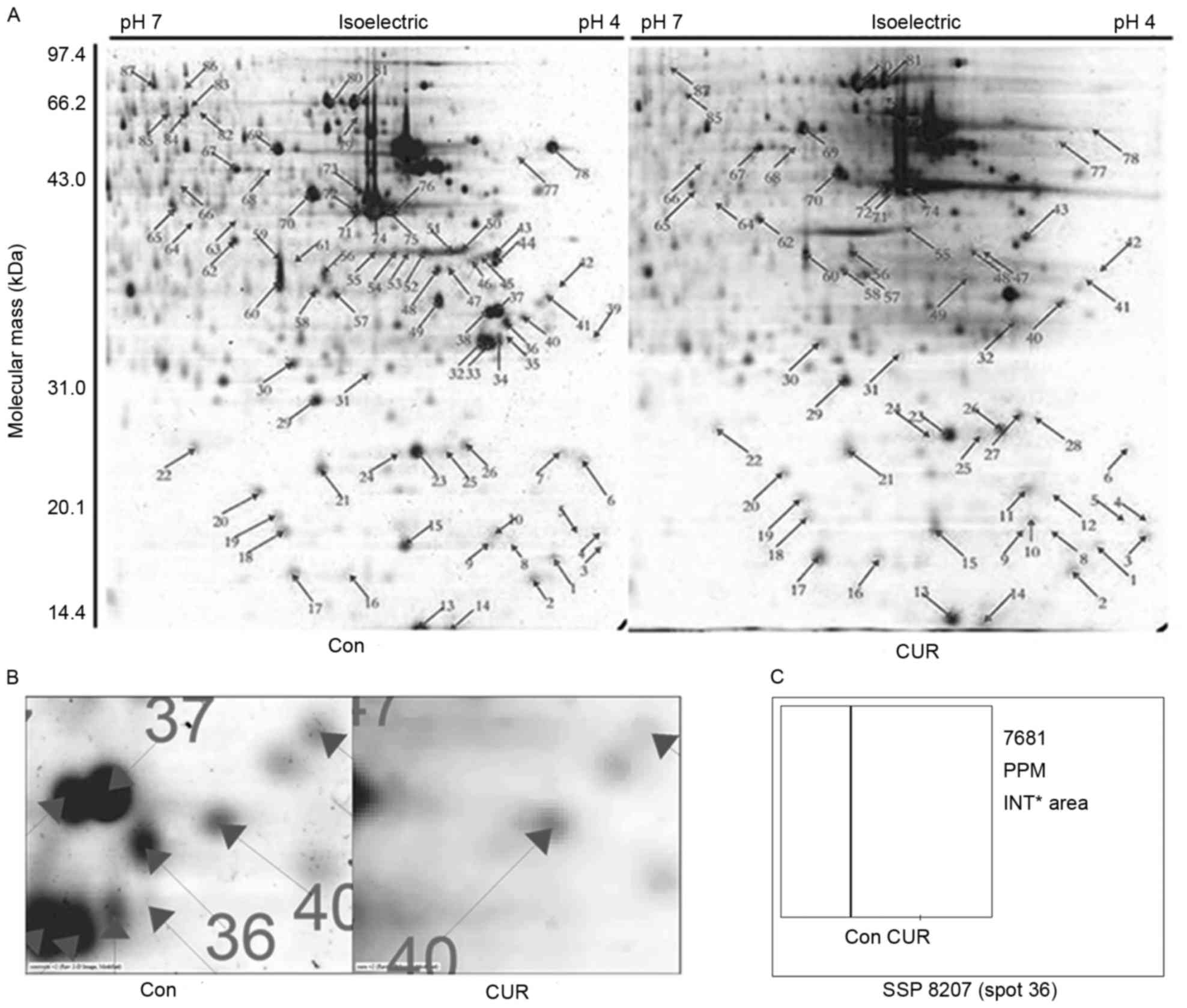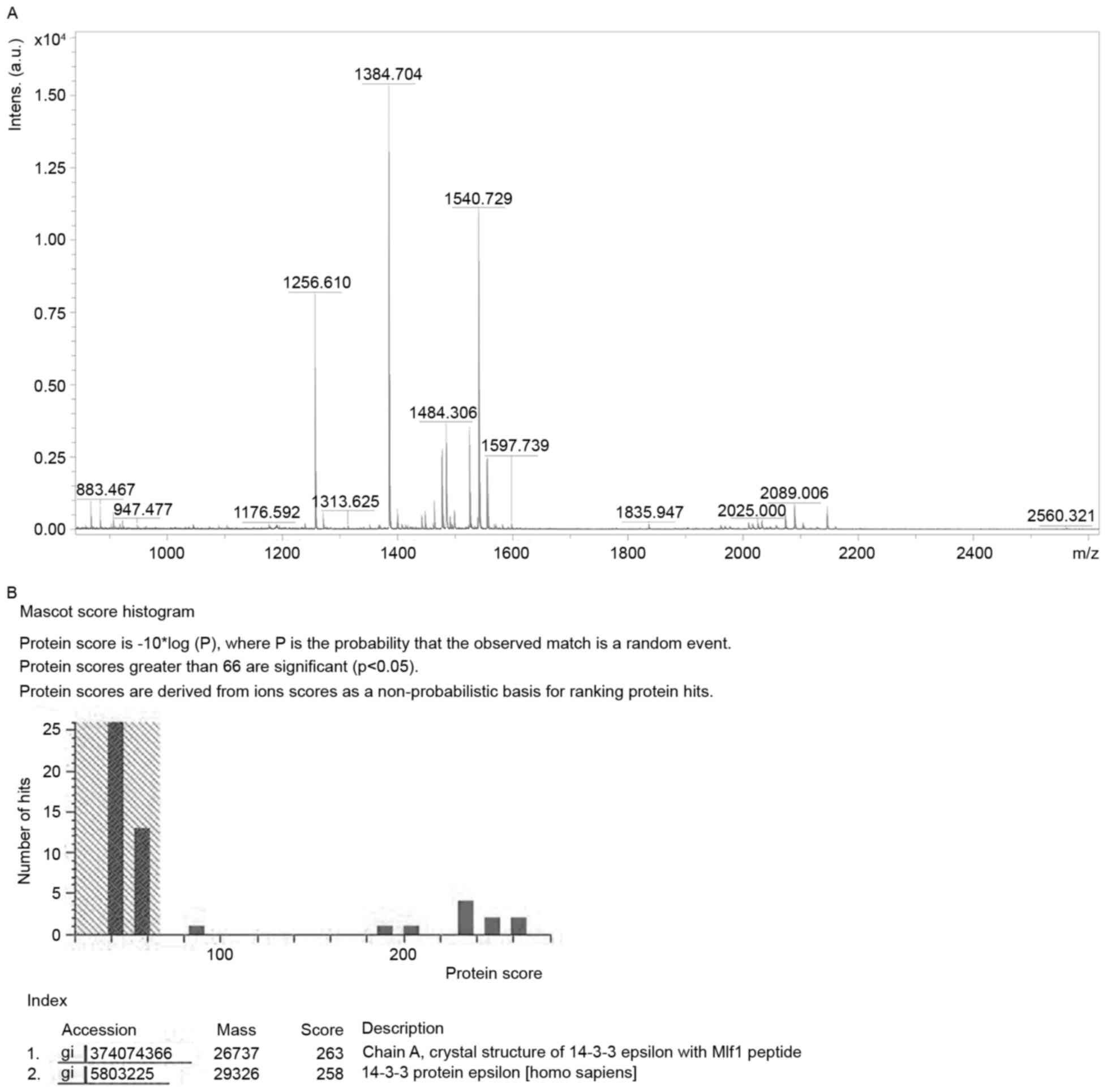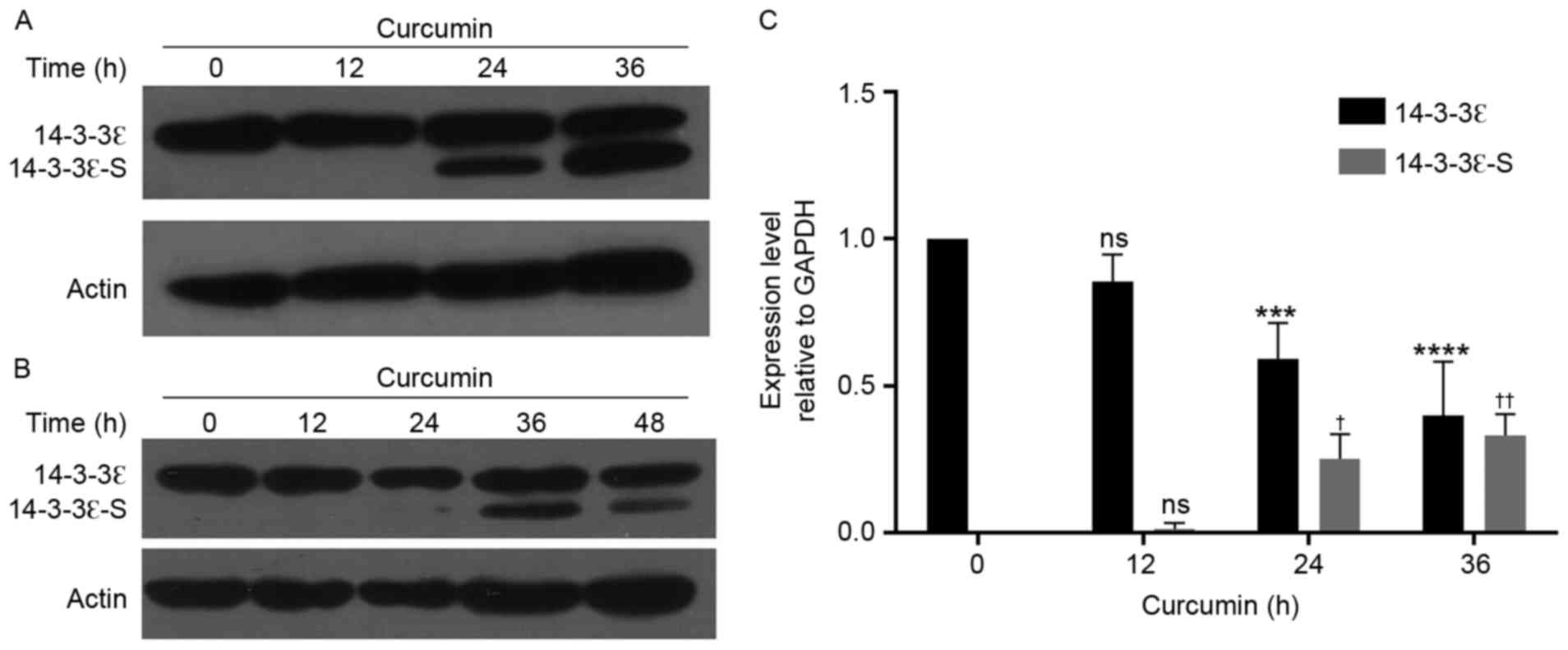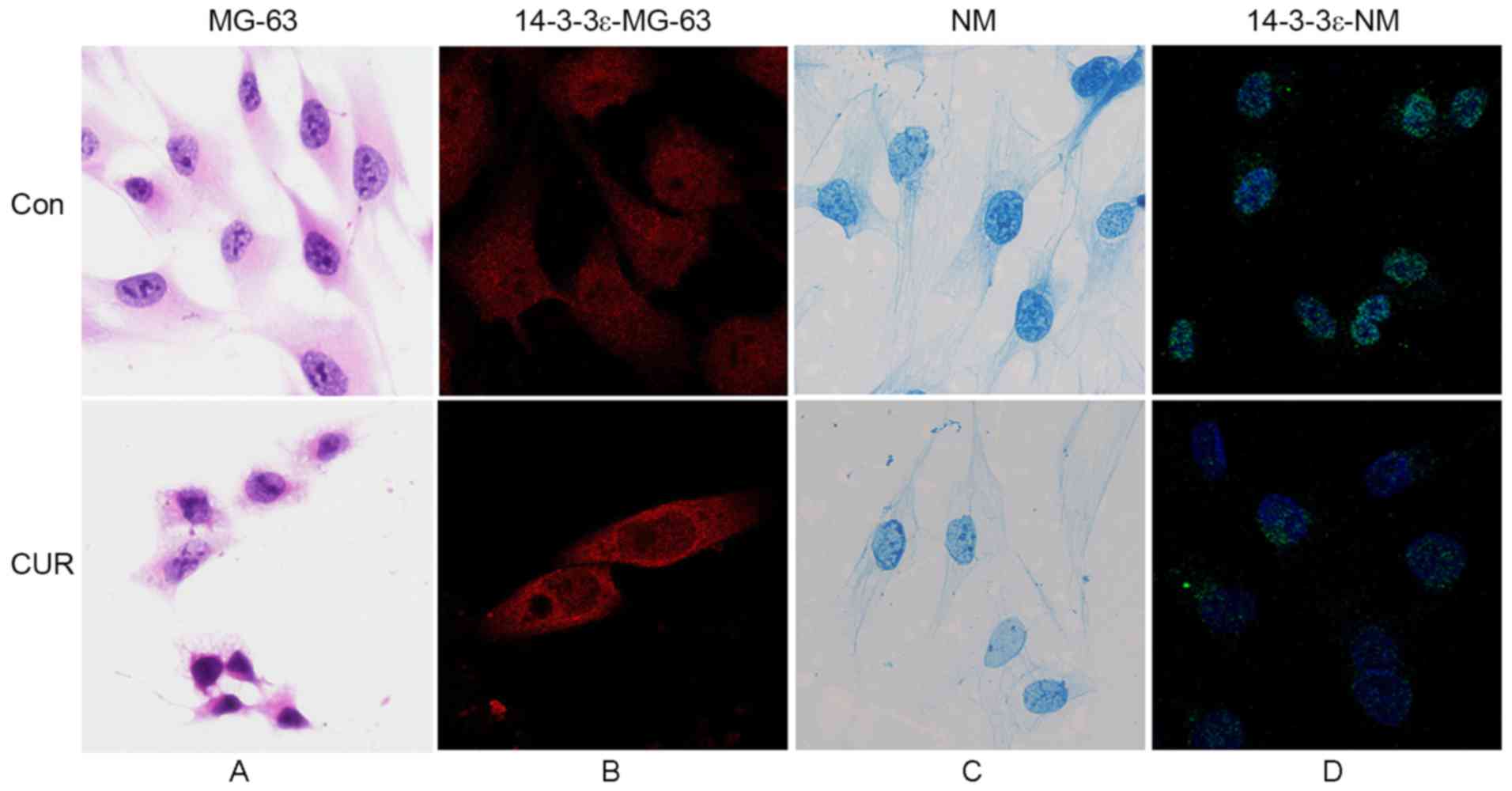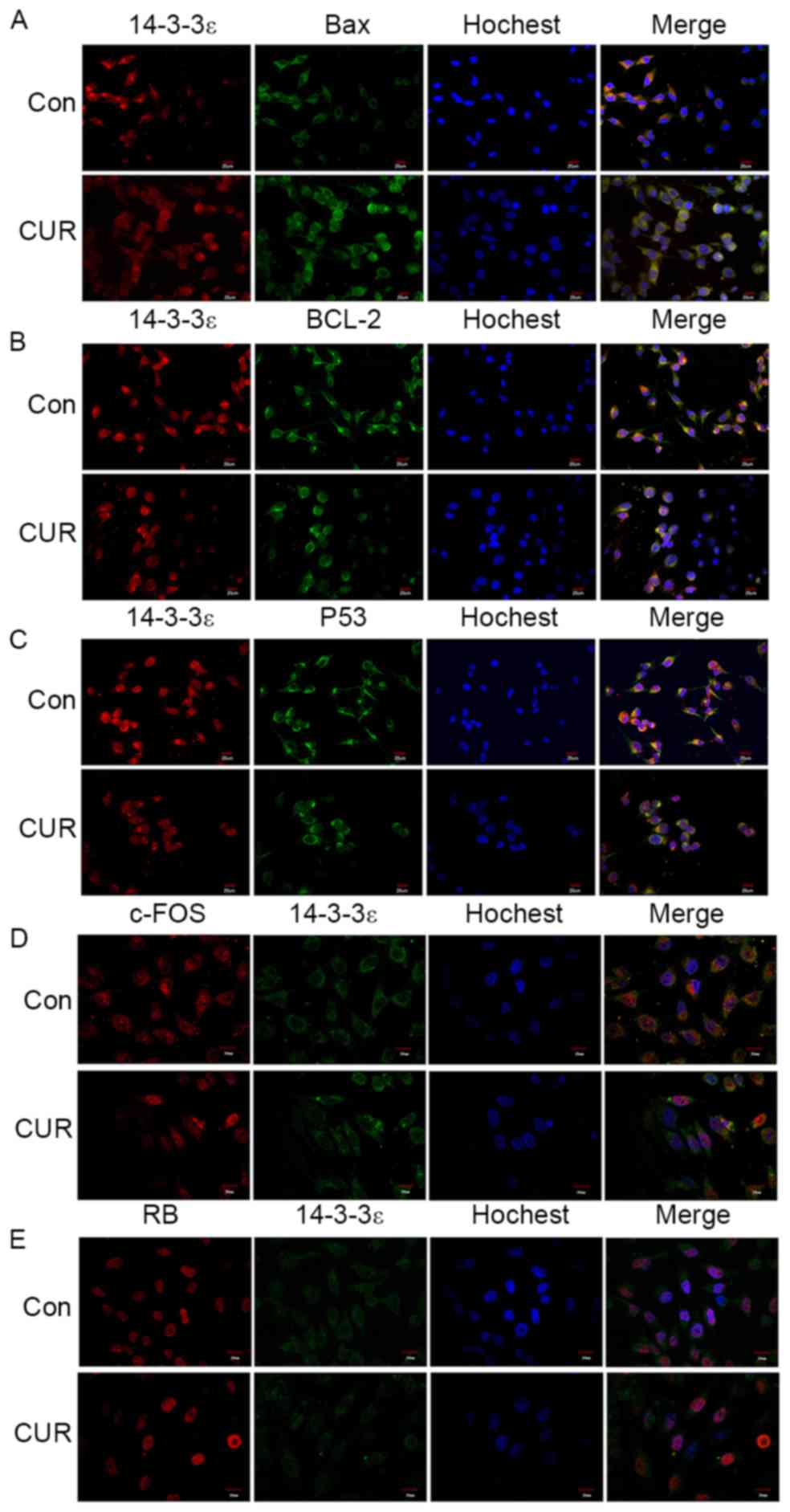|
1
|
Morrison DK: The 14-3-3 proteins:
Integrators of diverse signaling cues that impact cell fate and
cancer development. Trends Cell Biol. 19:16–23. 2009. View Article : Google Scholar : PubMed/NCBI
|
|
2
|
van Hemert MJ, Steensma HY and van Heusden
GP: 14-3-3 proteins: Key regulators of cell division, signalling
and apoptosis. Bioessays. 23:936–946. 2001. View Article : Google Scholar : PubMed/NCBI
|
|
3
|
Kosaka Y, Cieslik KA, Li L, Lezin G,
Maguire CT, Saijoh Y, Toyo-oka K, Gambello MJ, Vatta M,
Wynshaw-Boris A, et al: 14-3-3ε plays a role in cardiac ventricular
compaction by regulating the cardiomyocyte cell cycle. Mol Cell
Biol. 32:5089–5102. 2012. View Article : Google Scholar : PubMed/NCBI
|
|
4
|
Cui C, Ren X, Liu D, Deng X, Qin X, Zhao
X, Wang E and Yu B: 14-3-3 epsilon prevents G2/M transition of
fertilized mouse eggs by binding with CDC25B. BMC Dev Biol.
14:332014. View Article : Google Scholar : PubMed/NCBI
|
|
5
|
Nagappan A, Park HS, Park KI, Hong GE,
Yumnam S, Lee HJ, Kim MK, Kim EH, Lee WS, Lee WJ, et al:
Helicobacter pylori infection combined with DENA revealed altered
expression of p53 and 14-3-3 isoforms in Gulo-/- mice. Chem Biol
Interact. 206:143–152. 2013. View Article : Google Scholar : PubMed/NCBI
|
|
6
|
Zhong J, Kong X, Zhang H, Yu C, Xu Y, Kang
J, Yu H, Yi H, Yang X and Sun L: Inhibition of CLIC4 enhances
autophagy and triggers mitochondrial and ER stress-induced
apoptosis in human glioma U251 cells under starvation. PLoS One.
7:e393782012. View Article : Google Scholar : PubMed/NCBI
|
|
7
|
Liu Y, Song F, Wu WK, He M, Zhao L, Sun X,
Li H, Jiang Y, Yang Y and Peng K: Triptolide inhibits colon cancer
cell proliferation and induces cleavage and translocation of 14-3-3
epsilon. Cell Biochem Funct. 30:271–278. 2012. View Article : Google Scholar : PubMed/NCBI
|
|
8
|
Fong WH, Tsai HD, Chen YC, Wu JS and Lin
TN: Anti-apoptotic actions of PPAR-gamma against ischemic stroke.
Mol Neurobiol. 41:180–186. 2010. View Article : Google Scholar : PubMed/NCBI
|
|
9
|
Wang X, Grammatikakis N, Siganou A and
Calderwood SK: Regulation of molecular chaperone gene transcription
involves the serine phosphorylation, 14-3-3 epsilon binding, and
cytoplasmic sequestration of heat shock factor 1. Mol Cell Biol.
23:6013–6026. 2003. View Article : Google Scholar : PubMed/NCBI
|
|
10
|
Leal MF, Calcagno DQ, Demachki S,
Assumpcão PP, Chammas R, Burbano RR and Mde A Smith: Clinical
implication of 14-3-3 epsilon expression in gastric cancer. World J
Gastroenterol. 18:1531–1537. 2012. View Article : Google Scholar : PubMed/NCBI
|
|
11
|
Ruiz E, sparza-Garrido R, Velázquez-Flores
MÁ, Diegopérez-Ramirez J, López-Aguilar E, Siordia-Reyes G,
Hernández-Ortiz M, Martinez-Batallar AG, Encarnación-Guevara S,
Salamanca-Gómez F and Arenas-Aranda DJ: A proteomic approach of
pediatric astrocytomas: MiRNAs and network insight. J Proteomics.
94:162–175. 2013. View Article : Google Scholar : PubMed/NCBI
|
|
12
|
Ko BS, Jan YJ, Chang TC, Liang SM, Chen
SC, Liu TA, Wu YM, Wang J and Liou JY: Upregulation of focal
adhesion kinase by 14-3-3ε via NFκB activation in hepatocellular
carcinoma. Anticancer Agents Med Chem. 13:555–562. 2013. View Article : Google Scholar : PubMed/NCBI
|
|
13
|
Ko BS, Chang TC, Hsu C, Chen YC, Shen TL,
Chen SC, Wang J, Wu KK, Jan YJ and Liou JY: Overexpression of
14-3-3ε predicts tumour metastasis and poor survival in
hepatocellular carcinoma. Histopathology. 58:705–711. 2011.
View Article : Google Scholar : PubMed/NCBI
|
|
14
|
Liang S, Xu Y, Shen G, Liu Q, Zhao X, Xu
Z, Xie X, Gong F, Li R and Wei Y: Quantitative protein expression
profiling of 14-3-3 isoforms in human renal carcinoma shows 14-3-3
epsilon is involved in limitedly increasing renal cell
proliferation. Electrophoresis. 30:4152–4162. 2009. View Article : Google Scholar : PubMed/NCBI
|
|
15
|
Cimino D, Fuso L, Sfiligoi C, Biglia N,
Ponzone R, Maggiorotto F, Russo G, Cicatiello L, Weisz A, Taverna
D, et al: Identification of new genes associated with breast cancer
progression by gene expression analysis of predefined sets of
neoplastic tissues. Int J Cancer. 123:1327–1338. 2008. View Article : Google Scholar : PubMed/NCBI
|
|
16
|
Porter GW, Khuri FR and Fu H: Dynamic
14-3-3/client protein interactions integrate survival and apoptotic
pathways. Semin Cancer Biol. 16:193–202. 2006. View Article : Google Scholar : PubMed/NCBI
|
|
17
|
Zha J, Harada H, Yang E, Jockel J and
Korsmeyer SJ: Serine phosphorylation of death agonist BAD in
response to survival factor results in binding to 14-3-3 not
BCL-X(L). Cell. 87:619–628. 1996. View Article : Google Scholar : PubMed/NCBI
|
|
18
|
Nomura M, Shimizu S, Sugiyama T, Narita M,
Ito T, Matsuda H and Tsujimoto Y: 14-3-3 Interacts directly with
and negatively regulates pro-apoptotic Bax. J Biol Chem.
278:2058–2065. 2003. View Article : Google Scholar : PubMed/NCBI
|
|
19
|
Zhang L, Chen J and Fu H: Suppression of
apoptosis signal-regulating kinase 1-induced cell death by 14-3-3
proteins. Proc Natl Acad Sci USA. 96:pp. 8511–8515. 1999;
View Article : Google Scholar : PubMed/NCBI
|
|
20
|
Brunet A, Kanai F, Stehn J, Xu J,
Sarbassova D, Frangioni JV, Dalal SN, DeCaprio JA, Greenberg ME and
Yaffe MB: 14-3-3 transits to the nucleus and participates in
dynamic nucleocytoplasmic transport. J Cell Biol. 156:817–828.
2002. View Article : Google Scholar : PubMed/NCBI
|
|
21
|
Fey EG, Wan KM and Penman S: Epithelial
cytoskeletal framework and nuclear matrix-intermediate filament
scaffold: Three-dimensional organization and protein composition. J
Cell Biol. 98:1973–1984. 1984. View Article : Google Scholar : PubMed/NCBI
|
|
22
|
Gerner C, Seelos C and Sauermann G:
Alteration of nuclear matrix protein composition during apoptosis
in rat embryo cells. Exp Cell Res. 238:472–480. 1998. View Article : Google Scholar : PubMed/NCBI
|
|
23
|
Michishita E, Kurahashi T, Suzuki T,
Fukuda M, Fujii M, Hirano H and Ayusawa D: Changes in nuclear
matrix proteins during the senescence-like phenomenon induced by
5-chlorodeoxyuridine in HeLa cells. Exp Gerontol. 37:885–890. 2002.
View Article : Google Scholar : PubMed/NCBI
|
|
24
|
Jing GJ, Xu DH, Shi SL, Li QF, Wang SY, Wu
FY and Kong HY: Aberrant expression of nuclear matrix proteins
during HMBA-induced differentiation of gastric cancer cells. World
J Gastroenterol. 16:2176–2182. 2010. View Article : Google Scholar : PubMed/NCBI
|
|
25
|
Shevchenko A, Wilm M, Vorm O and Mann M:
Mass spectrometric sequencing of proteins silver-stained
polyacrylamide gels. Anal Chem. 68:850–858. 1996. View Article : Google Scholar : PubMed/NCBI
|
|
26
|
Boutet E, Lieberherr D, Tognolli M,
Schneider M, Bansal P, Bridge AJ, Poux S, Bougueleret L and
Xenarios I: UniProtKB/Swiss-Prot, the manually annotated section of
the UniProt KnowledgeBase: How to use the entry view. Methods Mol
Biol. 1374:23–54. 2016. View Article : Google Scholar : PubMed/NCBI
|
|
27
|
NCBI Resource Coordinators, . Database
resources of the national center for biotechnology information.
Nucleic Acids Res. 45:D12–D17. 2017. View Article : Google Scholar : PubMed/NCBI
|
|
28
|
Li QF: Effect of retinoic acid on the
changes of nuclear matrix in termediate filament system in gastric
carcinoma cells. World J Gastroenterol. 5:417–420. 1999. View Article : Google Scholar : PubMed/NCBI
|
|
29
|
Poüs C, Klipfel L and Baillet A:
Cancer-related functions and subcellular localizations of septins.
Front Cell Dev Biol. 4:1262016. View Article : Google Scholar : PubMed/NCBI
|
|
30
|
Hsu YT, Wolter KG and Youle RJ:
Cytosol-to-membrane redistribution of Bax and Bcl-X(L) during
apoptosis. Proc Natl Acad Sci USA. 94:pp. 3668–3672. 1997;
View Article : Google Scholar : PubMed/NCBI
|
|
31
|
Boonstra J and Verkleij AJ: Regulation of
enzyme activity in vivo is determined by its cellular localization.
Adv Enzyme Regul. 44:61–73. 2004. View Article : Google Scholar : PubMed/NCBI
|
|
32
|
Zhao ZL, Li QF, Zheng YB, Chen LY, Shi SL
and Jing GJ: The aberrant expressions of nuclear matrix proteins
during the apoptosis of human osteosarcoma cells. Anat Rec
(Hoboken). 293:813–820. 2010. View
Article : Google Scholar : PubMed/NCBI
|
|
33
|
Bai Z, Ye Y, Liang B, Xu F, Zhang H, Zhang
Y, Peng J, Shen D, Cui Z, Zhang Z and Wang S: Proteomics-based
identification of a group of apoptosis-related proteins and
biomarkers in gastric cancer. Int J Oncol. 38:375–383.
2011.PubMed/NCBI
|
|
34
|
Wyllie AH: Apoptosis (the 1992 Frank Rose
Memorial Lecture). Br J Cancer. 67:205–208. 1993. View Article : Google Scholar : PubMed/NCBI
|
|
35
|
Bazhanova ED, Sukhanov DS and Teplyi DL:
Pathways of apoptosis regulation in hepatocytes induced by
first-line antitubercular drugs. Bull Exp Biol Med. 158:650–653.
2015. View Article : Google Scholar : PubMed/NCBI
|
|
36
|
Wu JS, Cheung WM, Tsai YS, Chen YT, Fong
WH, Tsai HD, Chen YC, Liou JY, Shyue SK, Chen JJ, et al:
Ligand-activated peroxisome proliferator-activated receptor-gamma
protects against ischemic cerebral infarction and neuronal
apoptosis by 14-3-3 epsilon upregulation. Circulation.
119:1124–1134. 2009. View Article : Google Scholar : PubMed/NCBI
|
|
37
|
Wong RS: Apoptosis in cancer: From
pathogenesis to treatment. J Exp Clin Cancer Res. 30:872011.
View Article : Google Scholar : PubMed/NCBI
|
|
38
|
Won J, Kim DY, La M, Kim D, Meadows GG and
Joe CO: Cleavage of 14-3-3 protein by caspase-3 facilitates bad
interaction with Bcl-x(L) during apoptosis. J Biol Chem.
278:19347–19351. 2003. View Article : Google Scholar : PubMed/NCBI
|
|
39
|
Samuel T, Weber HO, Rauch P, Verdoodt B,
Eppel JT, McShea A, Hermeking H and Funk JO: The G2/M regulator
14-3-3sigma prevents apoptosis through sequestration of Bax. J Biol
Chem. 276:45201–45206. 2001. View Article : Google Scholar : PubMed/NCBI
|
|
40
|
Selvakumaran M, Lin HK, Miyashita T, Wang
HG, Krajewski S, Reed JC, Hoffman B and Liebermann D: Immediate
early up-regulation of bax expression by p53 but not TGF beta 1: A
paradigm for distinct apoptotic pathways. Oncogene. 9:1791–1798.
1994.PubMed/NCBI
|
|
41
|
Meek DW: The p53 response to DNA damage.
DNA Repair (Amst). 3:1049–1056. 2004. View Article : Google Scholar : PubMed/NCBI
|
|
42
|
Fridman JS and Lowe SW: Control of
apoptosis by p53. Oncogene. 22:9030–9040. 2003. View Article : Google Scholar : PubMed/NCBI
|
|
43
|
Gbormittah FO, Haab BB, Partyka K,
Garcia-Ott C, Hancapie M and Hancock WS: Characterization of
glycoproteins in pancreatic cyst fluid using a high-performance
multiple lectin affinity chromatography platform. J Proteome Res.
13:289–299. 2014. View Article : Google Scholar : PubMed/NCBI
|
|
44
|
Milde-Langosch K: The Fos family of
transcription factors and their role in tumourigenesis. Eur J
Cancer. 41:2449–2461. 2005. View Article : Google Scholar : PubMed/NCBI
|
|
45
|
Smeyne RJ, Vendrell M, Hayward M, Baker
SJ, Miao GG, Schilling K, Robertson LM, Curran T and Morgan JI:
Continuous c-fos expression precedes programmed cell death in vivo.
Nature. 363:166–169. 1993. View Article : Google Scholar : PubMed/NCBI
|
|
46
|
Chen X, Shen J, Wang Y, Chen X, Yu S, Shi
H and Huo K: Up-regulation of c-Fos associated with neuronal
apoptosis following intracerebral hemorrhage. Cell Mol Neurobiol.
35:363–376. 2015. View Article : Google Scholar : PubMed/NCBI
|
|
47
|
Yu AY, Su QR, Wang L, Zhou J and Liu XH:
Effects of citalopram on the expression of PCNA and C-fos and cell
apoptosis in rat frontal cortical neurons after stress. Zhongguo
Ying Yong Sheng Li Xue Za Zhi. 30:439–442. 2014.(In Chinese).
PubMed/NCBI
|
|
48
|
Morales D, Skoulakis EC and Acevedo SF:
14-3-3s are potential biomarkers for HIV-related neurodegeneration.
J Neurovirol. 18:341–353. 2012. View Article : Google Scholar : PubMed/NCBI
|
|
49
|
Gelman BB and Nguyen TP: Synaptic proteins
linked to HIV-1 infection and immunoproteasome induction: Proteomic
analysis of human synaptosomes. J Neuroimmune Pharmacol. 5:92–102.
2010. View Article : Google Scholar : PubMed/NCBI
|
|
50
|
Toyo-oka K, Shionoya A, Gambello MJ,
Cardoso C, Leventer R, Ward HL, Ayala R, Tsai LH, Dobyns W,
Ledbetter D, et al: 14-3-3epsilon is important for neuronal
migration by binding to NUDEL: A molecular explanation for
Miller-Dieker syndrome. Nat Genet. 34:274–285. 2003. View Article : Google Scholar : PubMed/NCBI
|















